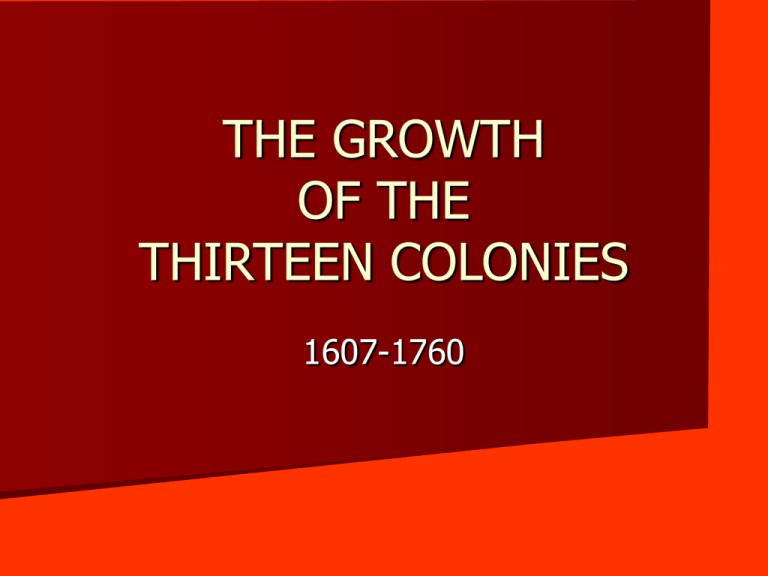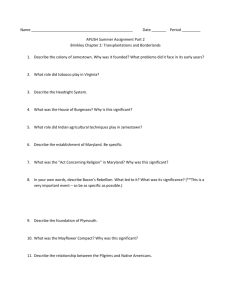13 Colonies
advertisement

THE GROWTH OF THE THIRTEEN COLONIES 1607-1760 Motivations for Colonization Jamestown – Economic prosperity – Single men hoped to make fortunes in Virginia and return to England – Previous explorers brought home tales of vast amounts of gold and other valuable resources – English patriotism – Adventurers wanted to stake English claim to prevent Spanish from taking over all of North America Motivations for Colonization Plymouth – Religious freedom – Puritans (Separatists) persecuted for rebelling against Church of England – Felt church had not completed the work of the Reformation – was too close to Roman Catholosism Founding of Colony Jamestown 1607 – Funded by London Company, a private enterprise – Granted charter by King James, but no funding – Company recruited people by promising that gold could be found by anyone who made the trip – King predetermined government of colony Founding of Colony Plymouth 1620 – Received funding from London Company – Treasurer of London C. was friends with one of the settlers – Separatists granted land in Virginia, but chose instead to settle in Plymouth – Some say this was a navigation mistake, however most historians feel this was on purpose – Signed Mayflower Compact to appease nonSeparatists on board who were rumored to be uneasy about settling somewhere other than specified land grant Initial Difficulties Jamestown – Laziness of colonists – Did not expect to do manual labor – Depended on natives for food – Disease and starvation killed 80% of the colonists in the first year – Failed attempts to befriend Indians let to multiple skirmishes Initial Difficulties Plymouth – Mayflower landed on December 21, many Pilgrims (name given to them MUCH later) died in harsh first winter – Attempts at agriculture initially failed Factors Contributing to Success Jamestown – Captain John Smith took control of government – instituted "no work, no eat" policy – firm leadership helped colony survive first few difficult years – ability to grow tobacco made land valuable – population grew as a result Factors Contributing to Success Plymouth – Strength of Mayflower Compact – this is more of a myth. The REAL fruit of their success was the fact that most of the natives had died from disease from early contact and colonists moved into already cleared land! – able leaders like William Bradford and Miles Standish – English-speaking Squanto, a survivor from previous explorations, taught Pilgrims to grow corn Factors Contributing to Success Plymouth – this cooperation led to the first Thanksgiving symbolized friendly relations between Pilgrims and Indians – Another myth. “Thanksgiving” is basically fall harvest festival and the natives had a tradition of this. The “pilgrims” were invited to eat with the Indians, not the other way around. Ask me where our Thanksgiving holiday actually derived from. Extra credit if you already know! – How many of you participated in a Thanksgiving play in elementary school? None of that actually happened!! Do you feel lied to? THE AMERICAN COLONIES Region NEW ENGLAND COLONIES MIDDLE COLONIES Geography Religion & Society Coastal areas with good harbors. Inland areas with dense forests. Poor rocky soil & short growing season. Small farms. Lumber mills. Fishing, Shipbuilding and Trade flourished. Cities developed along coast. Most people organized as congregations. (Puritans) Lived on farms, Merchants controlled trade. Artisans made goods, unskilled workers and slaves provided labor. Fertile soil and long growing season. Colonies grew large amounts of rye, oats, barley, potatoes & wheat as cash crop. Cities on coast. Wealthiest people owned large farms & most business. Most farmers produced a small surplus. Tenants farmers rented land or worked for wages. Religious diversity: Catholic, Quaker, Protestant Tobacco, rice & indigo grown on large plantations as cash crops. Wealthy elite controlled most land. Labor supply: indentured servants & African slaves. Religion: Anglican Rivers ran into backcountry. SOUTHERN COLONIES Government & Economy Favorable climate and soil for agriculture. Wide rivers made cities unnecessary. Colonies Grow and Develop Differently There are 13 colonies. They are along the Atlantic coast. They were divided into three groups New England Middle Southern The ways of life were different. Ways of Life Climate differed Government & Economy Religion & Society The New England Colonies The Puritans and the Pilgrims united and formed the colony of Massachusetts The colony of Connecticut was founded by Thomas Hooker Tomas Hooker was a Puritan minister. He believed that the leaders where becoming to powerful in Massachusetts. Rhode Island was found by Roger Williams Life in Colonial England Most New Englanders were: Farmers Trade Sailing and by the sea They used ships called schooners were used to catch cod They also were known for whaling They used the whales for oil Boston was the largest city in the New England colonies. Life in Colonial New England Schooling was very important to New Englanders. They believed that children should be able to read so they can read the Bible. Massachusetts past a law about public education in 1647. The law said every town with 50 families or more must have a school. The Middle Colonies The middle colonies unlike the other colonies had settlers from all different countries: Europe Germany Holland Sweden Henry Hudson explored the waterway called the Hudson River. The Dutch built a settlement called New Amsterdam. New Amsterdam then became New York when it was attacked by the English. The English also took New Sweden from the Dutch and called it New Jersey. The Middle Colony Of Pennsylvania William Penn a Quaker discovered Pennsylvania. The Quakers had limited rights. They did not belong to the Church of England. They were peace loving people. They believed in NO WAR. Penn was given land by King Charles II and Penn said this land would be used as a “FREE COLONY”. The Middle Colony Of Pennsylvania Founded in 1682 by Penn Became a special place of freedom People earned a trial by jury All people had the same rights in Pennsylvania Life in the Middle Colonies People lived on large farms far apart from each other. Families home schooled their children. The farms produced grains such as corn and wheat. They were known as the “Breadbasket of America”. Beaver fur was common for trade. The Southern Colonies Lord Baltimore founded the colony of Maryland. Maryland was the first colony to pass a law granting religious freedom. It was called the Act of Toleration Georgia was not a colony of religious freedom. Georgia was used as a refuge for prisoners. The prisoners were poor people who could not afford to pay their debt. Georgia then became a colony where people could work of their debt and gain a new start. The Southern Colonies The Carolinas were discovered and divided in the North and South because of large settlement populations. They came for religious freedom They came for a chance to prosper. Farms and Plantations in the Southern Colonies The farms produced large plantations of rice, indigo and tobacco. The big plantations were started along rivers on the coast.



